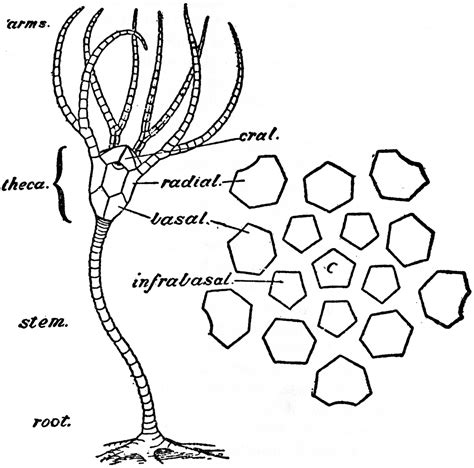Entry tags:
✑

anatomy of a crinoid (note the five-fold symmetry throughout the body!)
from the Treatise on Invertebrate Paleontology, Part T:
Morphologically the crinoid organism is divisible into several major parts: the stalk or column (here labeled “stem”), the theca which may be divided into the aboral cup or calyx, and an oral membrane or tegmen, and pinnule-bearing arms or brachia. The crinoid organism consists of a very voluminous body wall and only a relatively small body cavity. By far the largest part of the body cavity is lodged in the theca and only extensions of it consisting of small canals penetrate the stalk, arms, and pinnules. The bulk of the volume of the several internal organs systems is found in the central body cavity of the theca. The crinoid body wall is supported by a voluminous mesodermal endoskeleton, the form of which determines the total shape of the organism. Describing the crinoid form is practically the same as describing the form of the skeleton. …
The infrabasals of crinoids normally form a circlet of five small plates at the aboral¹ pole of the theca. They are disposed in radial position and rest upon the topmost columnal². …
The basals are primarily five in number, forming a circlet near the aboral pole of the theca between the circlet of infrabasals and the circlet of radials, with both of which they alternate, being interradial in position. The basals have synostosial sutural contacts with both infrabasals and radials³. …
Regularly crinoids have five radials arranged in a circle in the cup. The radial circlet may be interrupted by primary interradials and by an anal plate…The radials alternate with the basals and are connected to them with sutural contacts of synostosial type. Each radial is followed by a series of brachial plates⁴, with the first of which it has a muscular articulation⁵.
¹ opposite the mouth
² stalk segment
³ fancy way of saying that they’re fused together
⁴ plates connecting arms (brachia) to the theca
⁵ these muscles allow it to move its arms around to grab at food and pull it toward the mouth!
→ Treatise on Invertebrate Paleontology, Part T (Echinodermata 2: Crinoidea): https://journals.ku.edu/InvertebratePaleo/article/view/5642/5116
→ figure from the 1911 Encyclopædia Britannica, Vol. 8: https://en.wikisource.org/wiki/1911_Encyclop%C3%A6dia_Britannica/Echinoderma